Redefine Your Core Beyond the Crunches: 5 Best Ab Exercises
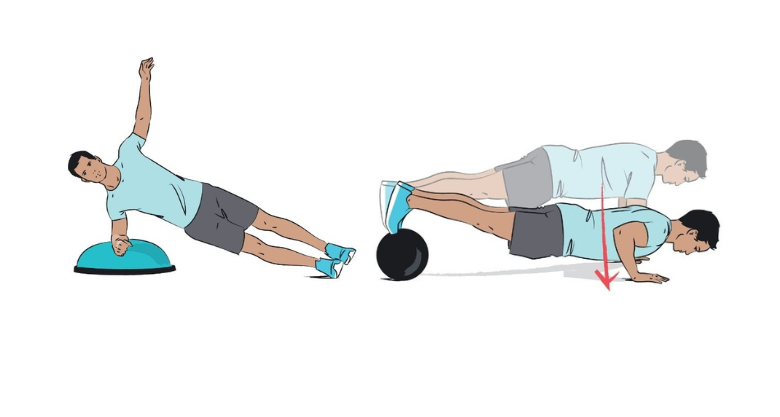
When it comes to core strength, many of us focus solely on crunches and sit-ups. While these exercises target the abdominal muscles, they only tell part of the story. Your core is a complex network of muscles that extends far beyond your abs.
By understanding the true nature of your core and incorporating a variety of exercises into your routine, you can enhance stability, improve posture, and unlock your full athletic potential. Let’s explore the key components of a strong core and discover exercises to target them effectively.
5 Best Core Exercises
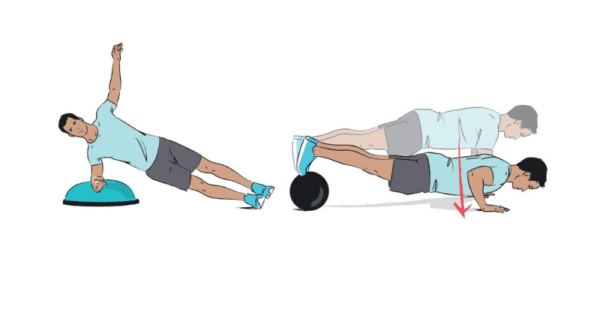

Anatomy of the Core Muscles
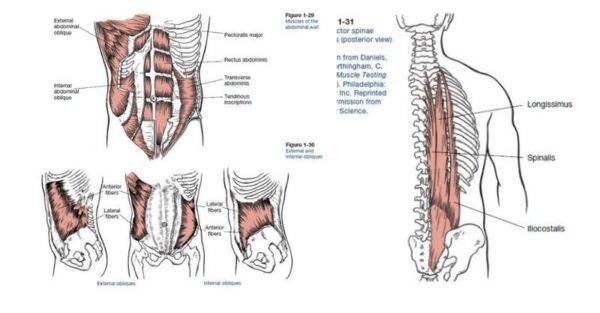

Depending on who you talk to, you may receive a very long list of muscles that make up the core of a very short list. For our purposes, let’s define the core as the following group of muscles (1):
- Internal and External Obliques. Running along the sides of the trunk are two groups of small, interconnected muscles known collectively as the obliques. These muscles provide stability to the trunk and are highly active during motions requiring rotation.
- Rectus Abdominis. The RA is what most people think of as the “6-pack muscles”. This band of tissue lies in the dead center of the abdomen, and many lifters strive to develop a perfectly defined rectus abdominis over their lifetimes.
- Multifidi. These little-known muscles lie on either side of the spine and provide support during rotational and bending movements.
- Glutes. One of the strongest muscles in the body, the glutes can affect our posture and stability throughout the spine.
- Muscles of the Pelvic Floor. In recent years, physical therapists have dedicated much more energy to improving the strength and stability of the pelvic floor. When this area is strong, many people notice improved posture, decreased back pain, and fewer instances of incontinence.
Of course, there are many other muscles that could be included in the core.
But the above list provides a general starting point to provide the reader with a basic understanding of how broadly we can apply the term “core muscles”.
Core Exercise Basics
So, what exactly are core exercises, if they aren’t just abdominal movements like crunches?
Core exercises can be thought of as encouraging the lifter to use his or her muscles to provide stability, rather than a surface like a bench.
For example, one might consider two distinct movements to understand what core exercise is:
- Bench press on a machine.
- Pushups with feet on a stability ball.
Granted, each of these exercises primarily strengthens the pecs, shoulders, and triceps.
However, when a person performs a core exercise such as push-ups on a stability ball, he also works his obliques, many different leg muscles, and tons of stabilizers throughout the body.
Also, it should be said that there is nothing wrong with performing a traditional exercise, such as using a bench press machine.
But core exercise tends to give the lifter a lot more “bang for the buck” so to speak.
Specifically, when one prioritizes core exercise, many more muscles are developed during each movement.
The 5 Best Core Exercises for Increasing Strength and Stability
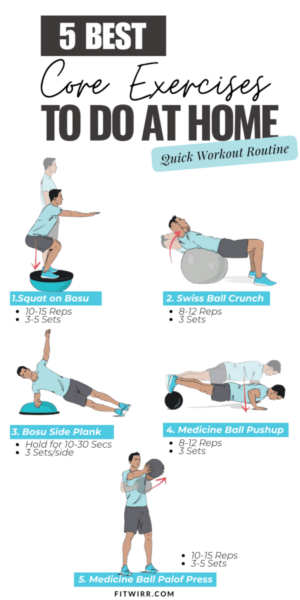

In this section, I’ll outline some of the best core exercises in existence. Additionally, I’ll show you how you can incorporate these movements into a killer workout!
1: Crunches on a Swiss Ball
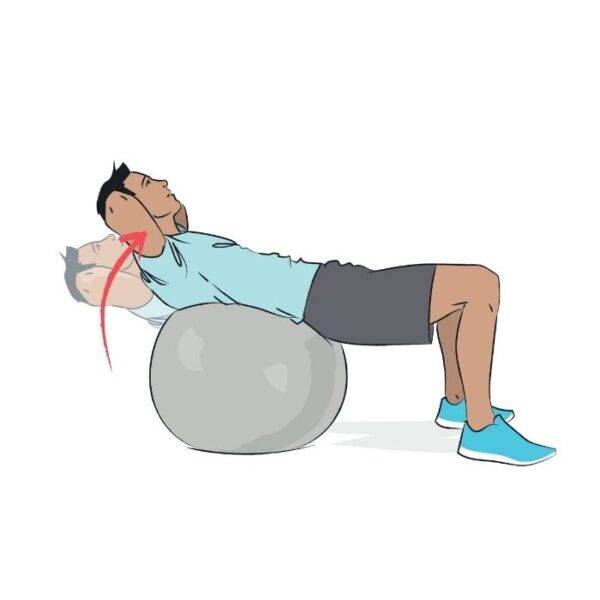

This exercise uses one of the most basic movements there is: the crunch, and adds in an element of instability in the form of a swiss ball.
These crunches can be tricky to master, but give it some time and you’ll be repping these out like it’s nothing!
Muscles Used:
- rectus abdominis
- obliques
- various leg/back muscles for stability and balance.
How to Perform
- Start by sitting on the ball.
- Slowly start to walk your legs forward, allowing yourself to lie down on the ball.
- Place both hands across your chest, or on your temples.
- Perform a crunch by contracting your abdominal muscles and lifting your shoulder blades off of the ball.
- Slowly return to the starting position to complete the rep.
- Complete 10-15 repetitions per set, 3-5 sets per session.
2: Medicine Ball Palof Press
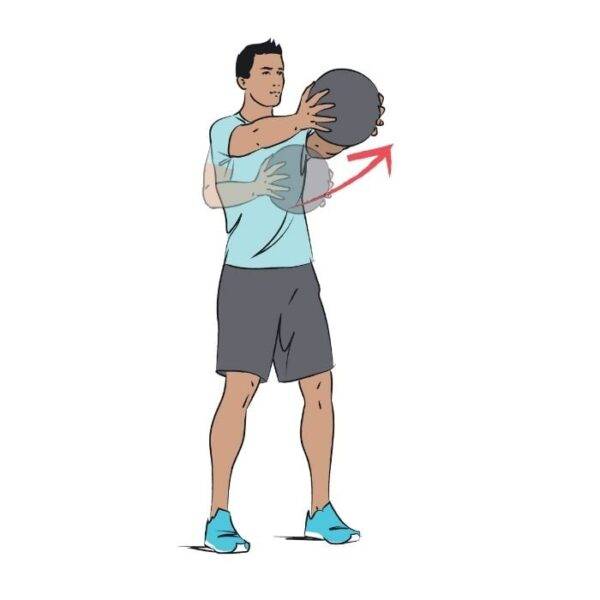

The Palof press is a phenomenal exercise for developing trunk and shoulder stability.
Best of all, it can also be performed with band resistance, adding in a new element of balance and strength!
Muscles Used:
- Obliques deltoids
- erector spinae
- various shoulder and trunk muscles for stability.
How to Perform
- Select a medicine ball that is challenging for you to hold, but not so heavy that you have to sacrifice good form.
- Hold the ball with both hands at chest height.
- Slowly push the ball out in front of you until your arms are fully extended.
- Hold this position for 5 seconds, then bend your arms, returning the ball to your chest to complete the rep.
- Perform 10-15 repetitions for 3-5 sets per session.
3: Pushups with Feet on Ball


Truth be told, this is a very difficult exercise. Be honest with yourself before attempting this one.
Only those who have fully mastered the pushup and the art of balancing on a ball should be performing this movement.
Muscles Used:
- obliques
- rectus abdominis
- pecs
- triceps
- various shoulder muscles
- multifidi, various leg muscles.
How to Perform
- Select a stability or medicine ball of appropriate size (try out some different sizes to see what works best for you!)
- Place both feet on the ball, and both hands on the ground, in proper push-up position.
- Keeping yourself steady, slowly lower your chest toward the ground.
- Once you’ve reached the bottom of your range, push yourself back up to the starting position, completing the rep.
- Perform 10-12 reps for 3-5 sets.
4: Squats on the Flat Side of the Bosu Ball
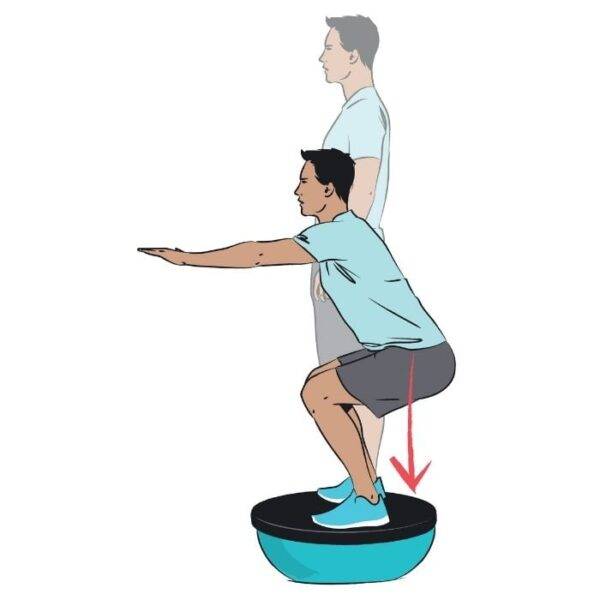

Warning: perform this movement near a wall or other stable surface.
Once you get situated on the ball, most first-timers have tons of difficulty keeping the Bosu from wiggling all over the place and throwing them off. This exercise really challenges the core muscles.
Muscles Used:
- Triple extensors (glutes, quads, calves)
- obliques
- erector spinae
- multifidi
- tons of muscles throughout the ankles, knees, hips, and trunk.
How to Perform
- Step carefully onto the flat side of the Bosu ball, using a wall or other supportive surface for balance.
- With your feet about hip-width apart, perform a squat by bending your knees and moving your hips down toward the ground.
- Keep the ball stable by using your core and ankle muscles throughout the movement.
- Perform 10-12 reps for 3-5 sets.
5: Side Plank on Bosu Ball


Performing exercises on the Bosu ball is equal parts challenging and rewarding. These tricky little tools create a tough surface on which to balance, no matter which side is facing up!
Muscles Used:
- Obliques,
- rectus abdominis,
- hip abductors,
- quadratus lumborum
- multifidi,
- various muscles of the trunk and shoulder.
How to Perform
- Start with your right forearm on the domed side of the Bosu ball.
- Stack your left foot on top of your right and lift your hips up towards the ceiling.
- Hold this position for 10-30 seconds, then slowly lower yourself down to the starting position.
- Perform 3-5 reps for 3-5 sets on each side per session.
15-Minute Core Workout
To effectively incorporate the above exercises into a workout, you shoulder to perform each of them as part of a circuit.
Specifically, structure this circuit workout so that you perform exercise one for the desired number of reps. Then, you should strive to move immediately on to exercise two, with as little rest as possible. Repeat this pattern until you’ve completed all of the exercises 3-5 times.
This workout can be performed as many as 4 times a week, or as few as once a week. It depends on your current level of fitness! If you’re unsure of how often you should perform exercises, talk with your physical therapist or doctor.
This workout will help to improve your cardiovascular endurance, as well as your strength and stability.
Final Takeaway on Core Exercises
Core exercise is an essential component of every fitness regimen. If you’ve never tried these intense stability exercises before, just be sure to go slow, don’t injure yourself, and talk with a medical professional if you have any questions!
